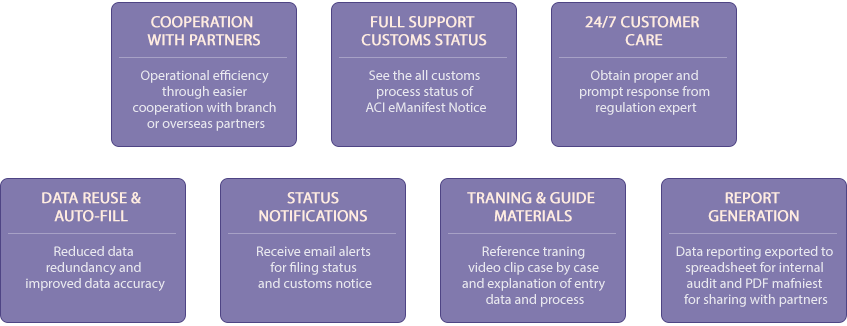
eVGM (e-Verified Gross Mass)
What is the Verified Gross Mass (VGM)?
The Safety of Life at Sea (SOLAS) Amendment will enter into force from July 1, 2016 and will affect all shippers, who are required to submit the verified gross mass of their packed containers prior to loading to ocean carrier. The verified gross mass is the combined weight of the container tare weight and the weight of all cargo, including packaging and dunnage. The new regulation will be enforced globally, but countries can issue their own guidelines based on the SOLAS requirement.
Who will be responsible for the VGM submission?
The ‘Shipper’ named on the ocean Bill of Lading is the party responsible for providing the VGM to the carrier. A VGM needs to be submitted for every container being loaded on the vessel, before the load list cut-off. If the VGM is not provided in due time, the container cannot be loaded. A shipper can authorise a third party to provide the VGM on their behalf.
What are the methods of weighing the container?

* Tare weight can be found on the container door or ocean carrier’s website when using Method 2.
What is a VGM cut-off?
As a general guidance, the VGM should be submitted prior to the cargo gate cut-off, before loading containers on the vessel. However, given the specific requirements implemented by each port and/or terminal, the cut-off for a VGM may vary and will therefore be communicated separately by ocean carrier’s local organizations. Most of ocean carriers will provide the cargo cut-off and deadlines for declaring a VGM at the time of booking via your Booking Confirmation.
What is the “No VGM, No Gate-in” policy?
Some terminals may adopt an additional buffer known as the “No VGM, No Gate-in” policy. This policy will prevent a packed container from entering the gate in the absence of the VGM. In the event of a terminal enforcing a “No VGM, No Gate-in” policy, the VGM will need to be submitted to ocean carriers in due time before Gate-in.
SmartLink eVGM Service

The SmartLink eVGM service allows shippers, forwarders, and non-vessel operators (NVOs) to submit the container weight verification data to about 30 carriers by EDI via INTTRA.
One click to send eVGM
On OPUS Forwarding, CyberLogitec FMS Solution, users can submit eVGM with only one click.
Provide Integration functions
Other FMS users may integrate eVGM submission function easily using XML format in their own system. SmartLink also provides eVGM submission function in WEB Portal system.
Features & Benefits
Features
Benefits
ACI eManifest
What is ACI eManifest House Bills?
Canada Border Services Agency (CBSA) requires freight forwarders for all modes of transportation to transmit advance house bill of lading (HBL) data electronically. The program eliminates paper-based house bill reporting and replaces legacy ACI supplementary data submitted to the CBSA. For most Canada-bound cargo, the data must be received prior to loading and validated by the CBSA prior to arriving in Canada.
Who is impacted?
All Freight Forwarders who handle the Canada-bound Cargo Freight forwarders with a bonded 8000-series carrier code can submit consolidated and non-consolidated house bill data. Freight forwarders with a non-bonded 8000-series carrier code can submit non-consolidated house bill data only. Important Note : Only freight forwarders physically located in Canada are eligible to apply for a bonded carrier code.
How does it work?
Freight forwarder should submit electronic House Bills and House Bills Close data.

Filing Time Frames
24 hours
prior to loading or arrival depending on type and origin of goods4 hours
prior to arrival or at time of departure2 hours
prior to arrival1 hour
prior to arrivalSmartLink eManifest House Bills Integration

Features & Benefits
